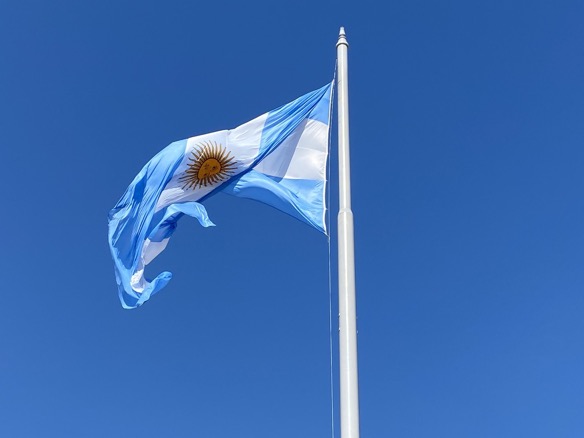Argentina: a Country of Extreme Contrasts 🇦🇷

At the end of February 2020, I travelled to Argentina on a humanitarian mission to assess the needs of drought-affected indigenous communities in Salta. The goal was to design a response that would help these communities cope with recurring climate shocks, particularly droughts, floods, and wildfires, which pose an increasing threat in northern Argentina and the Gran Chaco region.
Before heading to Salta, I spent several days in Buenos Aires, where I met with the EU Delegation, authorities, and local humanitarian partners to understand the broader context of the crisis. These discussions were insightful and essential, shaping how we would approach our work in Salta.
Buenos Aires – A City That Stole My Heart
While my time in Buenos Aires was mainly focused on work, I made sure to explore the city in my free moments—and it didn’t take long for me to fall in love with it. The architecture, the energy, the people—it was all captivating. The mix of European-style boulevards, lively cafés, and passionate tango performances made Buenos Aires feel both grand and intimate at the same time.
One of the most unexpected highlights was meeting Sebastian, a taxi driver of Polish heritage, with whom I quickly became friends. We stayed in touch even after I left Argentina, and I even got to know his wonderful mother, making this trip even more special on a personal level.
Salta – The Gateway to the North
Leaving Buenos Aires behind, I took a flight north to Salta, often called “La Linda” (The Beautiful)—and for good reason. Salta is surrounded by breathtaking mountain landscapes, colonial-era buildings, and vibrant markets where Andean culture thrives. The city’s mix of Spanish, Indigenous, and Criollo influences makes it one of the most culturally rich regions of Argentina.
After a few more meetings in Salta, I set off on a road trip with local organisations and the Argentinian Red Cross, travelling deeper into the Gran Chaco region, where communities were struggling with the impacts of drought and climate change.
The Vulnerabilities of Indigenous Communities in Gran Chaco
The Gran Chaco region, which spans Argentina, Paraguay, Bolivia, and Brazil, is one of the most fragile ecosystems in South America. It is home to many indigenous communities, including the Wichí, Qom, and Pilagá peoples, who have lived here for centuries. However, in recent years, their way of life has been increasingly threatened by:
• Droughts – Water scarcity is one of the most pressing issues. Many communities rely on seasonal rivers and rainwater collection, but long dry periods leave them without access to clean water.
• Floods – When rains do come, they often arrive in the form of intense storms, leading to flash floods that destroy homes, crops, and infrastructure.
• Wildfires – Rising temperatures and land clearance for agriculture and cattle ranching have made the region more prone to destructive fires, endangering both people and biodiversity.
• Xenophobia and Discrimination – Indigenous communities face systemic marginalisation, with limited access to healthcare, education, and job opportunities. They are often viewed as outsiders in their own country, leading to social exclusion and economic hardship.
• Unfair Practices by Big Companies – Large agribusinesses and logging companies have been rapidly expanding in northern Argentina, often exploiting the land without considering the rights of indigenous communities. This has led to deforestation, pollution, and the displacement of local populations.
• Land Grabbing – One of the biggest threats to indigenous land rights is illegal land appropriation. Powerful landowners and corporations frequently encroach upon ancestral lands, forcing communities into legal battles they cannot afford or directly pushing them out through intimidation.
Visiting the Affected Communities
With our humanitarian partners, we travelled to:
• General Ballivián – A small town deeply affected by water shortages, where local leaders explained how livelihoods were disappearing as agriculture became impossible.
• Tartagal – A key regional hub, where indigenous groups have been advocating for better access to water, healthcare, and legal recognition of their ancestral lands.
• Rivadavia Department – One of the most drought-affected areas, where the Wichí people struggle with malnutrition and lack of clean drinking water.
• Morillo – A remote village where we discussed disaster preparedness efforts, particularly ways to improve local water collection systems to withstand future droughts.
• San Pedro (Jujuy) – The final stop, where we learned about reforestation efforts and sustainable farming practices aimed at restoring some of the lost natural balance.
Humanitarian Response and Preparedness
Addressing these challenges requires both emergency relief and long-term solutions. Our work focused on:
• Water Access – Supporting the construction of rainwater harvesting systems and water purification technologies to reduce reliance on unpredictable natural sources.
• Food Security – Helping communities regain food sovereignty through sustainable agriculture, reforestation, and nutritional support for vulnerable groups.
• Disaster Preparedness – Strengthening early warning systems, fire prevention training, and emergency response networks to mitigate the impacts of future droughts, floods, and wildfires.
• Land Rights Advocacy – Supporting efforts to document and protect indigenous land ownership, ensuring that communities have legal defences against land grabbing.
• Social Integration and Legal Support – Collaborating with local and international organisations to reduce xenophobia, improve access to legal representation, and promote policies that protect indigenous rights.
A Mission That Left a Deep Impression
This trip to northern Argentina was one of the most impactful missions I had been on. Seeing the resilience of indigenous communities, despite the many challenges they face, was both heartbreaking and inspiring. The need for climate adaptation strategies, stronger legal protections, and inclusive policies is urgent, but so too is the determination of the people fighting for their future.
Leaving Salta, I felt a deep sense of purpose—knowing that, through humanitarian work, we could contribute to solutions that truly matter. It was a reminder that beyond statistics and reports, humanitarian efforts are about people—their lives, their struggles, and their hopes for a better future.
Click here to access the album.
